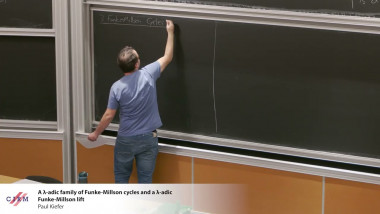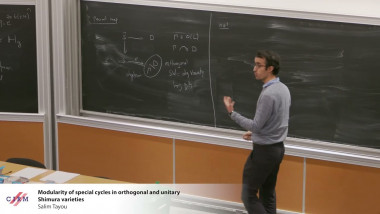
A $\lambda$-adic family of Funke-Millson cycles and a $\lambda$-adic Funke-Millson lift
De Paul Kiefer

Modularity of special cycles in orthogonal and unitary Shimura varieties
De Salim Tayou
Apparaît dans les collections : Jean-Morlet chair - Research school: Tiling dynamical system / Chaire Jean-Morlet - École de recherche : Pavages et systèmes dynamiques, Ecoles de recherche
Based on work done by Morse and Hedlund (1940) it was observed by Arnoux and Rauzy (1991) that the classical continued fraction algorithm provides a surprising link between arithmetic and diophantine properties of an irrational number $\alpha$, the rotation by $\alpha$ on the torus $\mathbb{T} = \mathbb{R}/\mathbb{Z}$, and combinatorial properties of the well known Sturmian sequences, a class of sequences on two letters with low subword complexity. It has been conjectured since the early 1990ies that this correspondence carries over to generalized continued fraction algorithms, rotations on higher dimensional tori, and so-called $S$-adic sequences generated by substitutions. The idea of working towards this generalization is known as Rauzy’s program. Although, starting with Rauzy (1982) a number of examples for such a generalization was devised, Cassaigne, Ferenczi, and Zamboni (2000) came up with a counterexample that showed the limitations of such a generalization. Nevertheless, recently Berthé, Steiner, and Thuswaldner (2016) made some further progress on Rauzy’s program and were able to set up a generalization of the above correspondences. They proved that the above conjecture is true under certain natural conditions. A prominent role in this generalization is played by tilings induced by generalizations of the classical Rauzy fractal introduced by Rauzy (1982). Another idea which is related to the above results goes back to Artin (1924), who observed that the classical continued fraction algorithm and its natural extension can be viewed as a Poincaré section of the geodesic flow on the space $SL_2(\mathbb{Z}) \ SL_2(\mathbb{R})$. Arnoux and Fisher (2001) revisited Artin’s idea and showed that the above mentioned correspondence between continued fractions, rotations, and Sturmian sequences can be interpreted in a very nice way in terms of an extension of this geodesic flow which they called the scenery flow. Currently, Arnoux et al. are setting up elements of a generalization of this connection as well. It is the aim of my series of lectures to review the above results.
